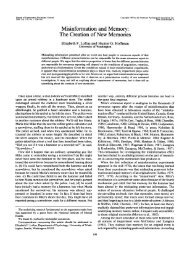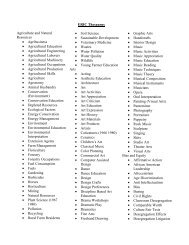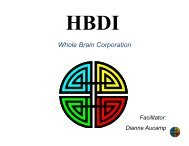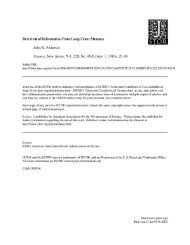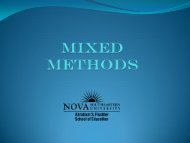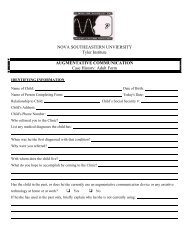Module 6 t tests.pdf - 1
Module 6 t tests.pdf - 1
Module 6 t tests.pdf - 1
You also want an ePaper? Increase the reach of your titles
YUMPU automatically turns print PDFs into web optimized ePapers that Google loves.
<strong>Module</strong> 6: t Tests<br />
The Applied Research Center
<strong>Module</strong> 6 Overview<br />
} Types of t Tests<br />
} One Sample t Test<br />
} Independent Samples t Test<br />
} Paired Samples t Test<br />
} Examples
t-Tests<br />
} Used for inferences concerning one or two means<br />
} 3 main types:<br />
} One-sample t-test<br />
} Independent samples t-test<br />
} Paired samples t-test
One Sample t-Test<br />
} Used to test whether the mean of single variable differs<br />
from a specified constant.<br />
} Example<br />
} A researcher wants to test whether the average IQ score of a<br />
group of students differs from 100.<br />
} A stats professor wants to determine whether the average<br />
grade on Assignment 1 differs significantly from 23 (an A<br />
average).
One Sample t-Test<br />
} Step 1: State the Null and Alternate Hypotheses<br />
} Ho = The average grade on Assignment 1 is equal to 23.<br />
} Ha = The average grade on Assignment 1 is not equal to<br />
23.<br />
} Is this a directional or nondirectional Ha?
One Sample t-Test (contd)<br />
} Step 2: Input each students grade into SPSS<br />
} Step 3: Run the Analysis.<br />
} Analyze à Compare Means à One Sample T-test<br />
} Test variable = assign1<br />
} Test value = 23<br />
} Click OK
One Sample t-Test (contd)<br />
One-Sample Statistics<br />
assign1<br />
Std. Error<br />
N Mean Std. Deviation Mean<br />
15 21.0333 1.54072 .39781<br />
One-Sample Test<br />
assign1<br />
Test Value = 23<br />
95% Confidence<br />
Interval of the<br />
Mean<br />
Difference<br />
t df Sig. (2-tailed) Difference Lower Upper<br />
-4.944 14 .000 -1.96667 -2.8199 -1.1134
One Sample t-Test (contd)<br />
} Step 4: Make a decision regarding the null<br />
} M = 21.03, SD = 1.54<br />
} t (14*) = -4.944<br />
} p < .001<br />
} What is the decision regarding the null?<br />
} *14 = df = n-1 = 15-1 = 14
One Sample t-Test (contd)<br />
} Using the level of significance = .05, do we reject or fail to<br />
reject the null?<br />
} If p < .05, we reject the null<br />
} if p > .05, we fail to reject the null<br />
} According to SPSS, p < .001<br />
} .001 < .05, therefore, we reject the null!
One Sample t-Test (contd)<br />
} Step 5: Write up your results.<br />
} The null hypothesis stated that the average grade on<br />
Assignment 1 is equal to 23. A one sample t-test revealed<br />
that the average grade on Assignment 1 (M = 21.03, SD =<br />
1.54) differed significantly from 23, t (14) = -4.944, p < .<br />
001. Consequently, the null hypothesis was rejected.
Independent t-Test<br />
} The independent samples t-test is used to test<br />
comparative research questions<br />
} That is, it <strong>tests</strong> for differences in two group means or<br />
compares means for two groups of cases.
Independent t-Test (contd)<br />
} Example:<br />
} Suppose the stats professor wanted to determine<br />
whether the average score on Assignment 1 in one stats<br />
class differed significantly from the average score on<br />
Assignment 1 in her second stats class.
Independent t-Test<br />
} Step 1: State the Null and Alternate Hypotheses<br />
} Ho = There is no difference between class 1 and class 2<br />
on Assignment 1.<br />
} Ha = There is a difference between class 1 and class 2 on<br />
Assignment 1.<br />
} Is this a directional or nondirectional Ha?
Independent t-Test (contd)<br />
} Step 2: Input each students grade into SPSS, along with<br />
which class they are in<br />
Grade Class<br />
20.00 1.00<br />
20.50 1.00<br />
21.00 1.00<br />
20.50 1.00<br />
20.00 1.00<br />
24.50 2.00<br />
23.50 2.00<br />
20.00 2.00<br />
20.00 2.00
Independent t-Test (contd)<br />
} Step 3: Run the Analysis.<br />
} Analyze à Compare Means à Independent Samples T-test<br />
} Test variable = assign1<br />
} Grouping variable = class<br />
} Define Groups:<br />
} Type 1 next to Group 1<br />
} Type 2 next to Group 2<br />
} Click Continue<br />
} Click OK
Independent t-Test (contd)<br />
Group Statistics<br />
assign1<br />
class<br />
1.00<br />
2.00<br />
Std. Error<br />
N Mean Std. Deviation Mean<br />
14 21.1786 1.48851 .39782<br />
13 21.9038 1.93525 .53674<br />
Independent Samples Test<br />
assign1<br />
Equal variances<br />
assumed<br />
Equal variances<br />
not assumed<br />
Levene's Test for<br />
Equality of Variances<br />
F<br />
Sig.<br />
t df Sig. (2-tailed)<br />
t-test for Equality of Means<br />
Mean<br />
Difference<br />
95% Confidence<br />
Interval of the<br />
Std. Error Difference<br />
Difference Lower Uppe<br />
4.519 .044 -1.096 25 .283 -.72527 .66152 -2.08771 .637<br />
-1.086 22.530 .289 -.72527 .66810 -2.10894 .658
Independent t-Test (contd)<br />
} Step 4: Make a decision regarding the null<br />
} Class 1 (M = 21.18, SD = 1.49)<br />
} Class 2 (M = 21.90, SD = 1.94)<br />
} Which row do we look at on the output?
Independent t-Test (contd)<br />
} Step 5: Levenes Test for equal variances<br />
} Ho = The variances of the two variables are equal.<br />
} Ha = The variances of the two variables are not equal.<br />
assign1<br />
Equal variances<br />
assumed<br />
Equal variances<br />
not assumed<br />
Levene's Test for<br />
Equality of Variances<br />
F<br />
Sig.<br />
Independent Samples Test<br />
p = .044,<br />
which is
Independent t-Test (contd)<br />
} Looking at the Equal variances not assumed row (the<br />
bottom row)<br />
Independent Samples Test<br />
Levene's Test for<br />
Equality of Variances<br />
t-test for<br />
assign1<br />
Equal variances<br />
assumed<br />
Equal variances<br />
not assumed<br />
F Sig. t df Sig. (2-tailed)<br />
4.519 .044 -1.096 25 .283<br />
-1.086 22.530 .289
Independent t-Test (contd)<br />
} Make a decision regarding the null<br />
} t (22.5) = -1.086<br />
} p = .289<br />
} Using the level of significance = .05, do we reject or fail to<br />
reject the null?
Independent t-Test (contd)<br />
} Remember<br />
} If p < .05, we reject the null<br />
} if p > .05, we fail to reject the null<br />
} According to SPSS, p = .289<br />
} .289 > .05, therefore, we fail to reject the null!!
Independent t-Test (contd)<br />
} Step 5: Write up your results.<br />
} The null hypothesis stated that there is no difference<br />
between class 1 and class 2 on Assignment 1. An<br />
independent samples t-test revealed that the average<br />
grades on Assignment 1 did not differ significantly from<br />
Class 1<br />
(M = 21.18, SD = 1.49) to Class 2 (M = 21.90, SD = 1.94),<br />
t (22.5) = -1.086, p = .289. Consequently, the researcher<br />
failed to reject the null hypothesis.
Paired Samples t-Test<br />
} Used to compare the means of two variables for a single<br />
group.<br />
} The procedure computes the differences between values<br />
of the two variables for each case and <strong>tests</strong> whether the<br />
average differs from 0.
Paired Samples t-Test<br />
} Example<br />
} A researcher wanted to know the effects of a reading<br />
program. The researcher gave the students a pretest,<br />
implemented the reading program, then gave the students a<br />
post test.
Paired Samples t-Test<br />
} Step 1: State the Null and Alternate Hypotheses<br />
} Ho = There is no difference in students performance<br />
between the pretest and the posttest.<br />
} Ha = Students will perform better on the posttest than<br />
on the pretest.<br />
} Is this a directional or nondirectional Ha?
NOTE for One-tailed Tests!!<br />
} Remember when we have a directional hypothesis, we<br />
conduct a one-tailed test.<br />
} When we have a non-directional hypothesis, we conduct a<br />
two-tailed test.<br />
} SPSS (unless given the choice) automatically runs a 2-<br />
tailed test, IF you have a directional alternate hypothesis<br />
(and a 2-tailed test was run), you MUST divide the p-value<br />
by 2 to obtain the correct p-value!
Paired Samples t-Test<br />
} Step 2: Set up data<br />
Pre Post<br />
20.00 25.00<br />
21.00 24.00<br />
19.00 23.00<br />
18.00 22.00<br />
20.00 24.00<br />
21.00 25.00
Paired Samples t-Test<br />
} Step 3: Analyze the Results<br />
} Analyze à Compare Means à Paired Samples t-Test<br />
} Paired variables: pre--post
Paired Samples t-Test (contd)<br />
Paired Samples Statistics<br />
Pair<br />
1<br />
pre<br />
post<br />
Std. Error<br />
Mean N Std. Deviation Mean<br />
19.8333 6 1.16905 .47726<br />
23.8333 6 1.16905 .47726<br />
Paired Samples Test<br />
Pair 1<br />
pre - post<br />
Paired Differences<br />
95% Confidence<br />
Interval of the<br />
Std. Error Difference<br />
Mean Std. Deviation Mean Lower Upper t df Sig. (2-tailed)<br />
-4.00000 .63246 .25820 -4.66372 -3.33628 -15.492 5 .000
Paired Samples t-Test (contd)<br />
} Step 4: Make a decision regarding the null<br />
– Pretest (M = 19.83, SD = 1.17)<br />
– Posttest (M = 23.83, SD = 1.17)<br />
– t (5) = -15.49<br />
– p < .001 (two-tailed)<br />
} What is the decision regarding the null?
Paired Samples t-Test (contd)<br />
} We have a directional alternate, therefore we have to<br />
divide the p-value by 2.<br />
Paired Samples Test<br />
Paired Differences<br />
95% Confidence<br />
Interval of the<br />
Std. Error Difference<br />
Std. Deviation Mean Lower Upper t df Sig. (2-tailed)<br />
.63246 .25820 -4.66372 -3.33628 -15.492 5 .000
Paired Samples t-Test (contd)<br />
} .000/2 = 0<br />
} p < .001<br />
} What is the decision regarding the null?
Paired Samples t-Test (contd)<br />
} Using the level of significance = .05, do we reject or fail to<br />
reject the null?<br />
– If p < .05, we reject the null<br />
– if p > .05, we fail to reject the null<br />
} According to SPSS, p < .001<br />
} .001 < .05, therefore, we reject the null!
Paired Samples t-Test (contd)<br />
} Step 5: Write up your results.<br />
} The null hypothesis stated that there is no difference<br />
in students performance between the pretest and<br />
the posttest. A paired samples t-test revealed that<br />
students scored significantly higher on the posttest<br />
(M = 23.83, SD = 1.17) than they did on the pretest<br />
(M = 19.83, SD = 1.17), t (5) = -15.49, p < .001.<br />
Consequently, the null hypothesis was rejected.
Directional Hypothesis Example<br />
} Suppose:<br />
– H a = Class 1 will score higher on Assignment 3 than Class 2.<br />
– à Must be based on literature (or prior data/test scores).<br />
} Run everything the same, only difference is final p-value!<br />
} According to SPSS, p = .289/2=.145<br />
} à still fail to reject the null!
Another Example<br />
} If H a = Class 1 will score higher on Assignment 3 than<br />
Class 2.<br />
} And SPSS reported a p-value of .08. When.08/2 = .04,<br />
which IS significant; in this case, we would reject the null!
<strong>Module</strong> 6 Summary<br />
} Types of t Tests<br />
} One Sample t Test<br />
} Independent Samples t Test<br />
} Paired Samples t Test<br />
} Examples
Review Activity<br />
} Please complete the review activity at the end of the<br />
module.<br />
} All modules build on one another. Therefore, in order to<br />
move onto the next module you must successfully<br />
complete the review activity before moving on to next<br />
module.<br />
} You can complete the review activity and module as many<br />
times as you like.
Upcoming <strong>Module</strong>s<br />
} <strong>Module</strong> 1: Introduction to Statistics<br />
} <strong>Module</strong> 2: Introduction to SPSS<br />
} <strong>Module</strong> 3: Descriptive Statistics<br />
} <strong>Module</strong> 4: Inferential Statistics<br />
} <strong>Module</strong> 5: Correlation<br />
} <strong>Module</strong> 6: t-Tests<br />
} <strong>Module</strong> 7: ANOVAs<br />
} <strong>Module</strong> 8: Linear Regression<br />
} <strong>Module</strong> 9: Nonparametric Procedures




